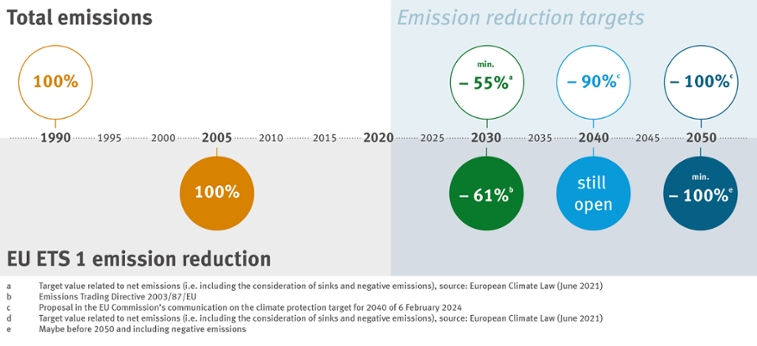European Climate Protection Targets
Adjusting Cap and Market Stability Reserve in EU ETS 1
The aim is to reduce emissions by at least 62 percent by 2030 compared to 2005. The adjustment of the cap after 2030 depends on the EU climate target for 2040, which is currently under discussion.

The EU has agreed to achieve climate neutrality within the EU by 2050 and to align European climate policy accordingly. The emissions reduction target for 2030 has been raised from a minimum of 40 per cent to at least 55 per cent compared to the 1990 level. Both targets are enshrined in law in the European Climate Change Act. The climate protection target for 2030 and the roadmap for achieving climate neutrality were also submitted to the UN Climate Change Secretariat as a national reduction contribution and long-term strategy under the Paris Agreement.
The EU climate target up to 2040 is currently being discussed. The EU Climate Law obliges the European Commission to propose this reduction target. It is publication of 06/02/2024, the European Commission (COM) therefore formulated a greenhouse gas (GHG) reduction target of 90 percent for the year 2040. In contrast, the UBA recommends a more ambitious target of 95 percent GHG reduction compared to 1990.
To support this process, the Commission plans to publish a communication in the first quarter of 2024 to prepare the ground for a legislative proposal to reform the European Climate Law. In this context, the UBA recommends that the European Commission aims for a reduction of 95 per cent compared to the 1990 level.
Adjusting the Cap up to 2030
The reforms outlined in the ‘Fit-for-55’ package will align the EU ETS 1, aiming for a reduction in emissions of approximately 62 percent by 2030 compared to 2005. This will contribute to the new EU climate protection target of at least a 55 percent reduction in greenhouse gas compared to 1990 levels. This will include all stationary sectors as well as aviation and maritime transport therefore adjusting the cap in EU ETS 1 accordingly. An early and ambitious cap adjustment is important. The aim is to achieve climate neutrality for the economy as a whole by the middle of the century at the latest. In addition, cumulative emissions should be kept as low as possible.
The linear reduction factor will increase from 2.2 percent to 4.3 percent in 2024, and again to 4.4 percent in 2028. It is determined as a proportion of the average number of allowances allocated in the second trading period (2008 to 2012) which means an annual reduction of 84 million EUAs in 2024 to 2027 and 86 million annually from 2028 onwards (including maritime transport in each case). In addition, extraordinary cap reductions are planned in 2024 (90 million allowances) and 2026 (27 million allowances) to bring the cap onto a linear emissions reduction path from 2021. In return, the cap will be slightly increased to take account of the inclusion of maritime transport in the EU ETS 1.
Offer Management through the Market Stability Reserve
The introduction of the Market Stability Reserve (MSR) in conjunction with the gradual lowering of the cap has helped to reduce the surplus on the carbon market and restore confidence in the steering function of the EU ETS 1.
The basic structure of the MSR has been retained during the reform of EU ETS 1. However, individual parameters have been adjusted. For example, the calculation of the Total Number of Allowances in Circulation (TNAC) now also involves aviation and maritime transport certificates. The doubled withdrawal rate of 24 per cent will now be applied until 2030.
The existing thresholds (400 million and 833 million certificates) have been retained. However, a new special rule applies to TNAC values between 833 and 1,096 million: in this range, the auction volume will be reduced by exactly the amount corresponding to the difference between TNAC and 833 million allowances. This is intended to prevent the MSR from reducing the total number of allowances in circulation below the upper threshold of 833 million.
The number of allowances held in the MSR will be limited to a maximum of 400 million allowances in the future. In 2023, around 2.5 billion EUAs were for the first time cancelled from the MSR; further cancellations on a smaller scale are expected in subsequent years.












